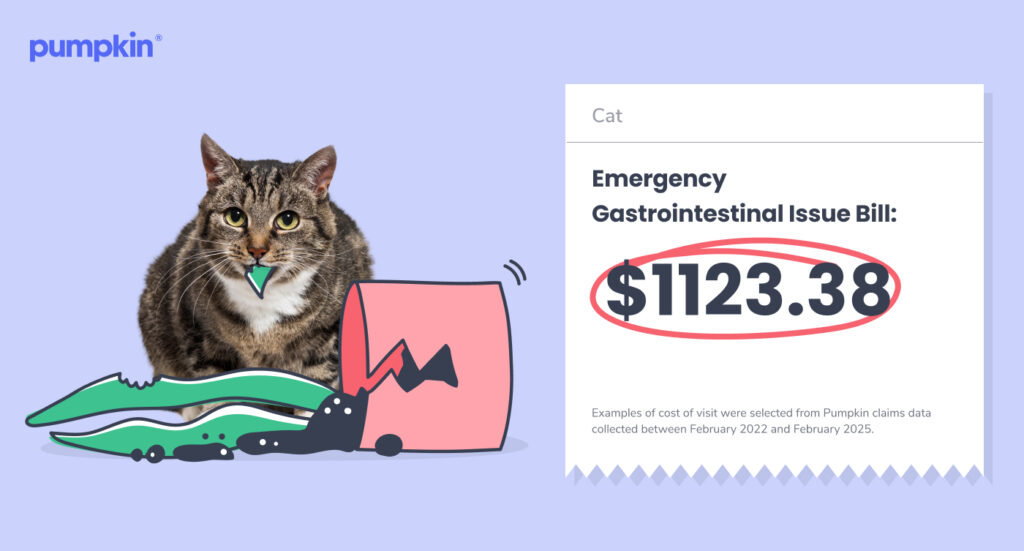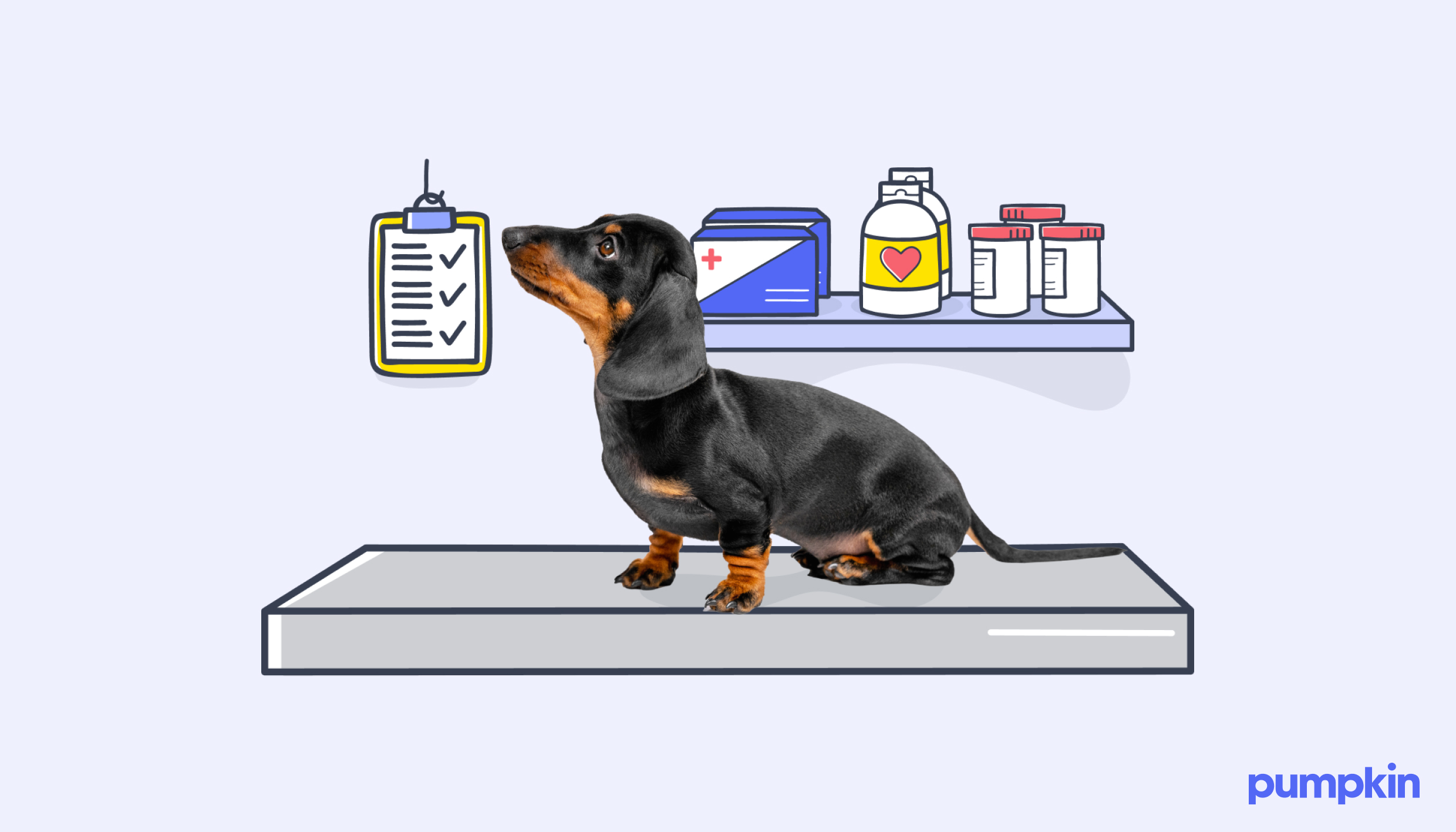Key Points
- Emergency vet visits range from a few hundred dollars to several thousand dollars, depending on the treatment needed.
- Pet insurance helps you manage unexpected vet bills, allowing you to get necessary care with less financial stress.
- Beyond pet insurance, there are also financing options available to help pet parents afford out-of-pocket vet costs.
Nobody wants to visit the local animal hospital with their beloved pet in tow. You may get stressed out just thinking about this possibility. But being prepared for the unexpected is an important part of pet parenthood.
Because when your dog decides to try and eat a whole box of chocolates or your cat mistimes a pounce and ends up with a limp, you need to be ready. And “ready” includes understanding the cost of emergency vet visits.
Let’s break down the average cost of common emergency vet treatments. And if you’re worried you can’t afford these vet bills, we’ll share some tips to help you cover out-of-pocket costs.
Emergency vet care by the numbers
Based on claims filed by Pumpkin pet parents between February 2022 and February 2025, the average emergency vet bill for dogs costs $653. The average cost of emergency care for cats is $919. Keep in mind there’s a huge range in prices depending on the type of care they receive. A complex canine cancer treatment could cost upward of $5,000, while a simple case of kitty constipation could set you back just $30 to $50.
These are just averages — the final cost depends on your location, your pet’s species, the type of injury or illness, what follow-up care is required, and whether you have pet insurance. For instance, a Pumpkin pup recently broke their leg and went home with a $12,388 bill, but Pumpkin paid back $9,441.1
While four or five-figure emergency vet bills are possible, they’re far from the norm.
How much do specific treatments cost?
Whether you have pet insurance or a dedicated savings account, you need to be ready for unexpected vet bills. To help you prepare, we gathered data and crunched the numbers. Here’s a look at what you could be facing financially for common pet emergencies:
Broken bones
Fractures are painful injuries in pets that require immediate vet care. Because they can range from simple breaks to complex fractures, the average cost of emergency fracture care in dogs and cats has an extra-wide range. Basically, the more serious the break, the more it’s going to cost. Case in point: One unlucky Pumpkin pup came home with a $12,000 bill for a broken leg.
But let’s talk averages. Among Pumpkin pets, the average claim for a fractured leg in dogs costs about $1,098, according to claims filed between January 2023 and February 2025. For cats, the average claim for a fractured leg was $791.
The type of fracture, the need for surgery, anesthesia, hospitalization, and follow-up care all influence the final bill.

Cancer
A cancer diagnosis is always terrifying, and treating common types of feline and canine cancer can be extraordinarily expensive. With pet insurance, you can minimize your out-of-pocket expenses and get reimbursed for a large portion of eligible vet bills, including for surgery, chemotherapy, medications, and diagnostic exams (bloodwork, X-rays, ultrasounds).
How much does emergency cancer treatment in pets cost on average? Unsurprisingly, there’s a wide range with this type of care, too. The location and progression of the tumor, the type of treatment required, your location, and your pet’s species all affect the final cost.
According to Pumpkin claims data, between February 2022 and February 2025, cancer-related emergency treatments cost anywhere from $307 to $4,057 in cats. In dogs, emergency treatments for cancer (including lymphoma, mast cell tumors, and melanoma) cost between $616 to $4,150. More complex cases can be even more expensive.
Cuts and lacerations
Car accidents and animal bites are common causes of wounds in dogs and cats, but your pet could also get a cut or laceration just romping about their daily life. While most minor cuts and scrapes can be treated at home, if the wound is deep or heavily bleeding, you’ll need emergency veterinary attention.
Serious wound treatment requires cleaning, stitches, and bandaging. Among Pumpkin pups, between February 2022 to February 2025, the average emergency claim for lacerations was $203, while bite wounds cost $420 to treat.
Deeper wounds that require sutures and follow-up care are naturally more expensive to treat.
Foreign body extraction
Ingestion of foreign objects sometimes requires emergency vet care. Usually, the vet will try to induce vomiting to expel the object (never try to make your dog throw up at home unless directed to do so by a veterinarian). If that doesn’t work, more invasive procedures like endoscopic removal or emergency surgery are necessary.
Endoscopies are generally cheaper while surgeries cost significantly more because they involve anesthesia, incisions, and a longer recovery time. For surgery, you can expect anywhere from $2,000 to $10,000, according to CareCredit2.
Other complications, like damages caused by the ingested object or hospitalization after surgery, will also influence the average cost of an animal hospital visit.
Seizures
Seizures are truly a frightening experience for both you and your pet, and unfortunately determining the underlying cause can be a long, complicated process.
Your vet will likely use a combination of tools to diagnose the cause and provide treatment, including blood tests, medication, and more advanced imaging if they can’t find the cause. According to Pumpkin claims data, between February 2022 and February 2025, emergency seizure treatment cost $1,788 on average for dogs.
Heatstroke
Heatstroke is a race against time — emergency vet care is absolutely necessary. Treatment involves cooling measures, IV fluids ($60-$95), and oxygen therapy ($50-$200).
The length of hospitalization and whether your pet needs intensive care will significantly affect your final bill. If your pet needs to stay at the hospital overnight, be prepared to dig a little deeper into your pockets. According to CareCredit3, the average overnight hospital stay for a dog ranges from $222-$567, while for a cat, it’s $99-$243.
Gastrointestinal issues
This is one of the most common illnesses in dogs and cats alike. Stomach issues like vomiting and diarrhea often pass on their own, but when GI issues get worse or come with other worrying symptoms, you may need to seek emergency treatment.
Between February 2022-2025, treatment for gastrointestinal issues in dogs cost $519-$1,514 and a whopping $1,123 in cats, according to Pumpkin claims data.

Allergies
Yes, our pets suffer from allergies too. From extreme cases of anaphylactic shock to simple skin issues like rashes, allergies sometimes require emergency care. Typically, allergy-related treatment isn’t as expensive as other types of care. Pumpkin claims data from February 2022-2025 shows that allergy treatment costs $170 to $215 on average for both dogs and cats.
Can pet insurance help with emergency vet costs?
Absolutely! Out-of-pocket emergency vet care costs without insurance can be incredibly expensive. A recent survey found that less than 50% of pet parents were financially prepared for a medical emergency.
Pet insurance is a helpful safety net for those unexpected accidents and illnesses that life throws your pet’s way. You pay monthly premiums hoping your pet never gets into an accident, but if they do get sick or injured, you’ll be grateful you have protection.
Here’s how pet insurance works: You pay a monthly premium for your pet insurance plan, and once your annual deductible is met, you file claims for eligible vet bills. If the claim is approved, you can get reimbursement for 50% to 90% of eligible vet bills. Your pet insurance plan may also have an annual limit, which caps the total reimbursement amount each year.
With Pumpkin Pet Insurance plans, all pet parents can choose a plan with a 90% reimbursement rate. Pumpkin plans also have flexible options for annual limits (including unlimited plans) and deductibles, letting you choose a plan that’s just right for your pet.
What type of emergency treatment does pet insurance cover?
Pet insurance can help you afford a wide range of emergency services. Of course, your coverage will depend on the plan you choose, your insurance provider, and the specifics of your claim. As Accident & Illness plans, pet insurance doesn’t reimburse you for routine, preventive care or pre-existing conditions.
That means it can be a lifesaver when you’re facing surprise emergency vet bills. Once your annual deductible has been met, you can file claims for emergency care such as:

- Examination fees
- Diagnostic tests: X-rays, ultrasounds, blood tests, etc.
- Emergency treatment: Medications, surgery, cancer treatment, wound care, and more
- Hospitalization: Overnight and inpatient hospital care
- Behavioral treatment: If your pet has a behavior problem that threatens their health, your pet insurance plan could help cover the costs of treatment
- Follow-up treatment
If your claim is approved, you’ll get cash back based on your plan’s reimbursement rate. So, while you still have to pay the initial bill upfront, you can get paid back for a large portion of the bill.
Remember: cheaper premiums usually mean lower reimbursement rates, higher deductibles, and exclusions for specific surgeries or illnesses.
That’s why it’s important to pick a plan that pays you back in the long run. Pumpkin Pet Insurance plans offer extensive coverage and can reimburse pet parents for up to 90% of covered vet bills.
How to finance emergency vet care
Pet insurance is a great way to prepare financially for medical emergencies, but there are other creative ways to cover vet bills. If you find yourself needing a little extra help, consider one of these options.
Online fundraisers
Rally the troops! Online fundraising platforms like GoFundMe allow you to raise money for your pet’s medical expenses. Share your pet’s story and reach out to your network of friends, family, or even strangers who are willing to support a good cause.
Pumpkin’s Tip: Be clear about the treatment needed and how funds will be used. Transparency builds trust and encourages people to donate.
CareCredit
CareCredit is a credit card designed for healthcare expenses, including veterinary care costs.
The service offers financing options and payment plans to spread out the cost of large vet bills over time, making unexpected costs much more manageable. Even if you have pet insurance, you’ll still need to pay for emergency vet treatment upfront. With a CareCredit credit card, you can take the sting out of these bills while you submit a claim.
Don’t get caught off guard
Are you prepared for emergency vet care? It’s not a rhetorical question, but a reality all pet parents have to face.
Don’t wait until disaster hits to think about finances. Being proactive is the best way to ensure your pet can get the care they need when they need it most. Ready to learn more about protecting your pet and your wallet with Pumpkin Pet Insurance plans? Get a free quote today.
FAQs
1. Example illustrates reimbursement of an eligible claim. Coverage and reimbursement rates vary based on policy options. Based on Pumpkin Insurance Services Inc Claims Data from 7/1/22-11/15/24. This does not guarantee coverage. Individual results may vary and statistics may change during different time periods.
2. Cat and Dog Intestinal Blockage Surgery Costs and Financing. CareCredit Well U. Published November 03, 2022. https://www.carecredit.com/well-u/pet-care/cat-and-dog-intestinal-blockage-surgery-cost-and-financing/
3. How Much Does an Emergency Vet Visit Cost?. CareCredit Well U. Published January 10, 2025. https://www.carecredit.com/well-u/pet-care/emergency-vet-visit-cost-and-veterinary-financing/




